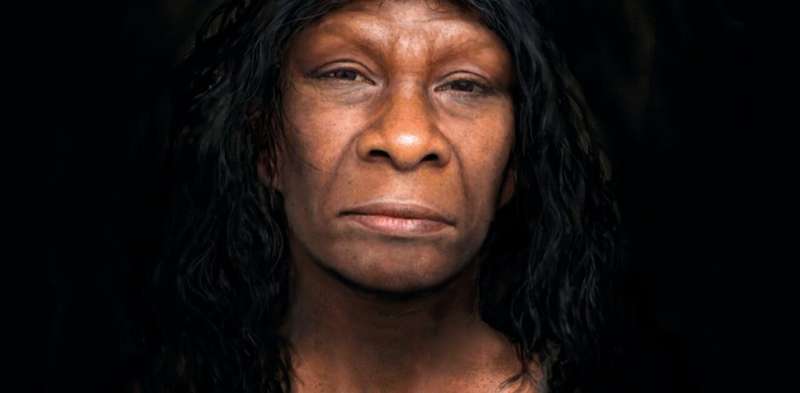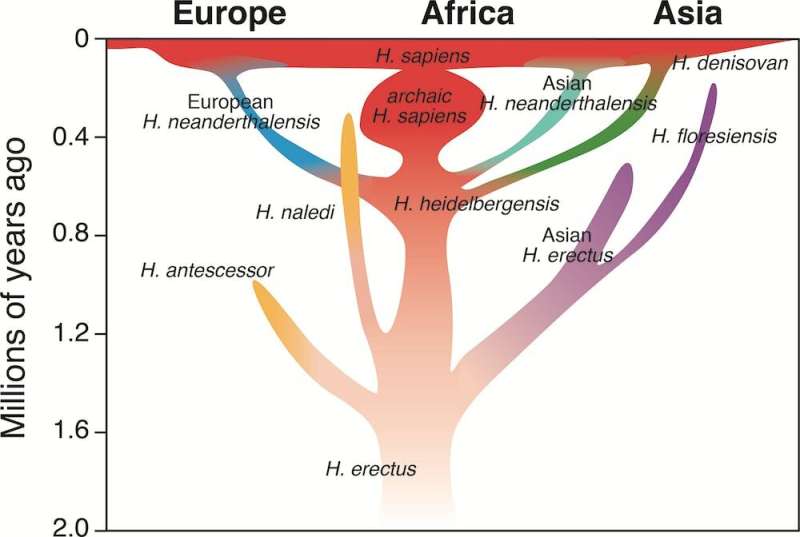Science, Art, Litt, Science based Art & Science Communication
 Credit: Tom Björklund / Moesgård Museum, Author provided
Credit: Tom Björklund / Moesgård Museum, Author providedNeanderthals have served as a reflection of our own humanity since they were first discovered in 1856. What we think we know about them has been shaped and molded to fit our cultural trends, social norms and scientific standards. They have changed from diseased specimens to primitive sub-humanlumbering cousins to advanced humans.
We now know Homo neanderthalensis were very similar to ourselves and we even met them and frequently interbred. But why did they go extinct, while we survived, flourished and ended up taking over the planet?
Neanderthals evolved over 400,000 years ago, most likely from an earlier ancestor Homo heidelbergensis. They were extremely successful and spread across an area from the Mediterranean to Siberia. They were highly intelligent, with brains on average bigger than Homo sapiens's.
They hunted for big game, collected plants, fungi, and seafood, controlled fire to cook, made composite tools, made clothes from animal skins, made beads from shells, and were able to carve symbols on to cave walls. They took care of their young, old and weak, created shelters for protection, lived through harsh winters and warm summers, and they buried their dead.
Neanderthals did meet our ancestors on several occasions over the course of tens of thousands of years and the two species shared the European continent for at least 14,000 years. They even mated with each other.
Death of a species
The most significant difference between Neanderthals and ourselves is that they went extinct about 40,000 years ago. The precise cause of their demise still eludes us, but we think it was probably the result of a combination of factors.
 Our common ancestor lived less than a million years ago. Credit: Kjærgaard, Nielsen & Maslin, Author provided
Our common ancestor lived less than a million years ago. Credit: Kjærgaard, Nielsen & Maslin, Author providedFirst the climate of the last ice age was very variable, shifting from cold to warm and back again, which put pressure on animal and plant food sources and meant Neanderthals constantly had to adapt to environmental change. Second there were never that many Neanderthals, with the overall population never exceeding the tens of thousands.
They lived in groups of five to 15 individuals, compared with Homo Sapiens that had groups of up to 150 individuals. These small isolated Neanderthal populations may have been increasingly genetically unsustainable.
Third there was competition with other predators, particularly the groups of modern humans that emerged from Africa about 60,000 years ago. We speculate that many Neanderthals may have been assimilated into the larger bands of Homo sapiens.
Where's the evidence?
Neanderthals left numerous traces for us to examine tens of thousands of years later, much of which can be seen at the special exhibition we have helped curate at the Natural History Museum of Denmark. Over the past 150 years we have collected fossil bones, stone and wooden tools, found trinkets and jewelry they left behind, uncovered burials, and now mapped their genome from ancient DNA. It seems that 99.7% of Neanderthal and modern human DNA is identical and they are our closest extinct relatives.
Perhaps the most surprising fact was evidence of interbreeding that has left traces of DNA in living humans today. Many Europeans and Asians have between 1% and 4% Neanderthal DNA while African people south of the Sahara have almost zero. Ironically, with a current world population of about 8 billion people, this means that there has never been more Neanderthal DNA on Earth.
The Neanderthal genome also helps us understand more of what they looked like, as there is evidence that some Neanderthals evolved pale skin and red hair long before Homo sapiens. The many genes that are shared between Neanderthals and modern humans are linked to anything from the ability to taste bitter foods to the capacity to speak.
 99.7% human. Credit: Tom Björklund / Moesgård Museum, Author provided
99.7% human. Credit: Tom Björklund / Moesgård Museum, Author providedWe have also increased our knowledge of human health. For instance, some Neanderthal DNA that might have been beneficial to humans tens of thousands of years ago now seems to cause issues when combined with a modern western lifestyle.
There are links to alcoholism, obesity, allergies, blood clotting, and depression. Recently, scientists suggested an ancient gene variant from Neanderthals might increase the risk of serious complications from contracting COVID-19.
Holding up a mirror
Like the dinosaurs, the Neanderthals didn't know what was coming. The difference is that the dinosaurs disappeared suddenly following a giant meteorite hit from outer space. To the Neanderthals extinction happened gradually. They eventually lost their world, a comfortable home they had successfully occupied for hundreds of thousands of years that slowly turned against them, until existence itself was unsustainable.
In that sense, Neanderthals now serve a different purpose. We see our reflection in them. They didn't know what was happening to them and they had no choice but to continue down the road that eventually led to extinction. We on the other hand are painfully aware of our situation and the impact we have on this planet.
Human activity is changing the climate and is leading straight into a sixth mass extinction. We can reflect on the mess we have landed ourselves in and we can do something about it.
If we don't want to end up like the Neanderthals, we better get our act together and collectively work for a more sustainable future. Neanderthal extinction reminds us that we should never take our existence for granted.
Authors: Peter C. Kjærgaard, Mark Maslin and Trine Kellberg Nielsen.
This article is republished from The Conversation under a Creative Commons license. Read the original article.![]()
***********************
What fossils reveal about hybridization of early humans
Many people living today have a small component of Neanderthal DNA in their genes, suggesting an important role for admixture with archaic human lineages in the evolution of our species. Paleogenetic evidence indicates that hybridization with Neanderthals and other ancient groups occurred multiple times, with our species' history resembling more a network or braided stream than a tree. Clearly the origin of humankind was more complex than previously thought.
It is essential to use multiple lines of evidence to investigate the impact of such hybridization. Ancient DNA is rarely well-preserved in fossil specimens so scientists need to recognize possible hybrids from their skeletons. This is vital for understanding our complex past and what makes us human.
Researchers investigated a large number of fossil remains of ancient humans from the Upper Paleolithic of Eurasia, dating to approximately 40 to 20 thousand years ago. Several of these individuals have yielded ancient DNA showing a small component of Neanderthal ancestry in their genes, reflecting their recent admixture with this group. Their skull bones were compared with (unadmixed) samples from Neanderthals and early, as well as recent, modern humans from Africa.
Researchers examined three regions of the skull: the mandible, the braincase and the face, for tell-tale signs of hybridization. These might include, for example, intermediate morphology compared to Neanderthals or modern humans, dental abnormalities or unusual sizes. These are features we see in hybrids of various mammals, including primates. Their study showed that signals of hybridization were evident in braincases and jaws, but not in faces.
In the individuals with known genetic background, the researchers also considered whether signs of hybridization on the skeleton matched the percentage of Neanderthal ancestry. The fact that it didn't suggests that "the presence of particular genetic variants is probably more important than the overall proportion of Neanderthal ancestry," the researchers say.
They also identified some of the individuals studied as potential hybrids, including individuals from the Middle East—well-known to be a region of contact for the groups—but also beyond, in both Western and Eastern Europe. However, where possible, individual hybrid status should be confirmed using genetic data, and as such the scientists consider these identifications as hypotheses to be tested. This was the first study of its kind they hope this encourages researchers to look more closely at these fossils and combine multiple lines of evidence for identifying hybridization in the fossil record.
Innovator of evolution
In other organisms—from plants to large mammals—hybridization is known to produce evolutionary innovation, including outcomes that are both novel and diverse. It is estimated that about 10 percent of animal species produce hybrids, including, for example, bovids, bears, cats and canids. Hybrids are also known in primates, our close relatives, such as baboons. Because hybridization introduces new variation, and creates new combinations of variation, this can facilitate particularly rapid evolution, especially when facing new or changing environmental conditions.
Hybridization, therefore, may have provided ancient humans with genetic and anatomical features which gave them important advantages when spreading from Africa across the world, resulting in our physically diverse and evolutionarily resilient species, state the researchers.
Katerina Harvati, Merging morphological and genetic evidence to assess hybridization in Western Eurasian late Pleistocene hominins, Nature Ecology & Evolution (2022). DOI: 10.1038/s41559-022-01875-z. www.nature.com/articles/s41559-022-01875-z
Views: 51
Replies to This Discussion
-
31
-
© 2025 Created by Dr. Krishna Kumari Challa.
Powered by
![]()